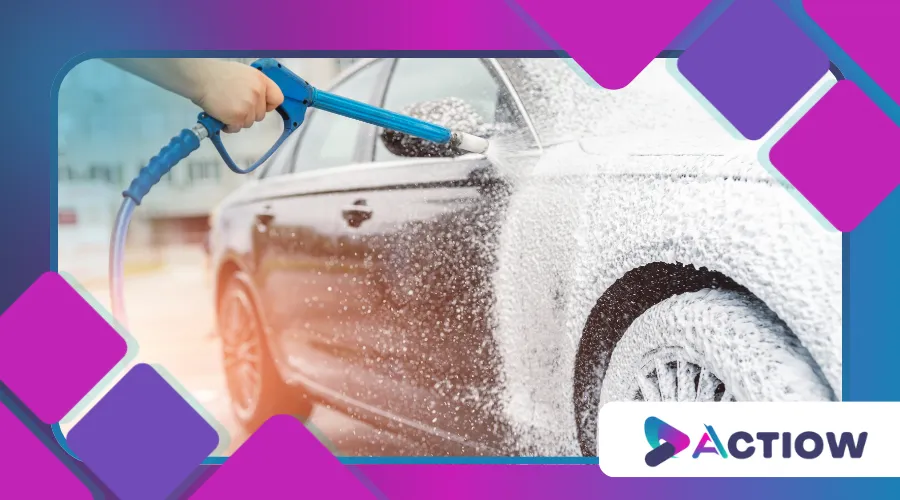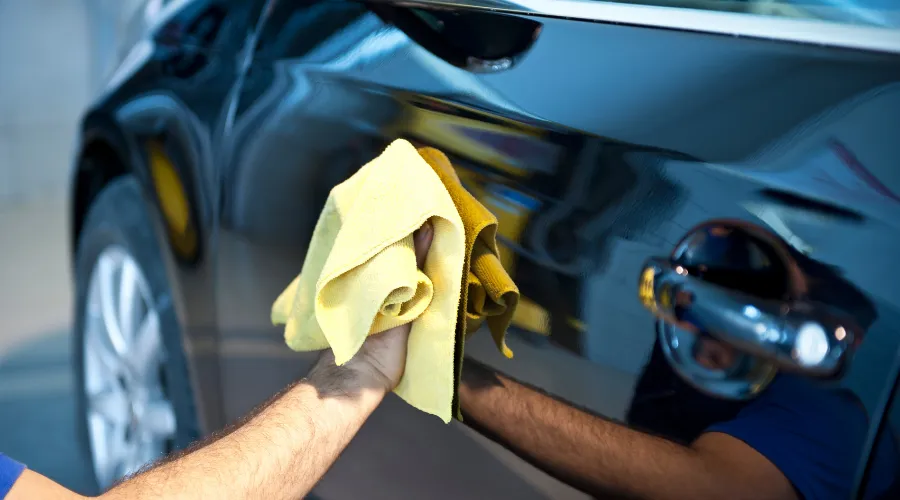How to Wash Your Car Properly Without Scratching the Paint

Anúncios
Washing your car might seem like a simple task, but doing it wrong can lead to unsightly scratches and long-term damage to your paint.
Learning how to wash your car properly is essential to maintaining its appearance and value.
Whether you’re a car enthusiast or just someone who wants to keep their vehicle looking sharp, this guide will walk you through the steps to achieve a flawless finish without harming your paint.
Anúncios
Properly washing your car not only enhances its visual appeal but also helps maintain its resale value.
When potential buyers see a well-maintained vehicle, they are more likely to pay a premium price, making your efforts worthwhile.
Why Proper Car Washing Matters
Your car’s paint is more than just a cosmetic feature—it’s a protective layer that shields the metal underneath from rust, UV rays, and environmental contaminants.
According to a study by the International Carwash Association, improper washing techniques are one of the leading causes of paint damage, including swirl marks and scratches.
By following the right methods, you can preserve your car’s shine and extend its lifespan.
Additionally, regular washing removes harmful substances like bird droppings and tree sap that can degrade the paint over time.
Taking the time to wash your car properly can prevent costly repairs and repainting in the future.
The Tools You’ll Need
Before diving into the process, gather the right tools.
Using the wrong materials is a common mistake that can lead to scratches.
Here’s what you’ll need:
- Microfiber Wash Mitts: These are gentle on paint and trap dirt effectively.
- pH-Neutral Car Shampoo: Harsh detergents can strip wax and damage paint.
- Two Buckets: One for soapy water and one for rinsing your mitt.
- Grit Guards: These prevent dirt from being reintroduced to your wash mitt.
- Microfiber Drying Towels: Soft and absorbent, they reduce the risk of scratches during drying.
- Wheel Brush: For cleaning tires and rims without damaging them.
It’s also beneficial to have a hose with a spray nozzle to control water flow.
This allows you to rinse off your car more efficiently and helps conserve water.
+ The History of Ferrari: How the Brand Became an Automotive Icon
Step-by-Step Guide to Wash Your Car Properly
1. Choose the Right Location
Washing your car in direct sunlight can cause water spots as the water evaporates too quickly.
Opt for a shaded area or wash your car early in the morning or late in the evening.
This not only helps prevent water spots but also keeps you comfortable while working.
A cooler environment can make the washing process more enjoyable and effective.
2. Rinse Thoroughly
Start by rinsing your car with a hose to remove loose dirt and debris.
This step prevents scratching when you start washing.
Pay special attention to the wheels and undercarriage, where grime tends to accumulate.
A thorough rinse ensures that you’re not pushing dirt into the paint during the washing process.
This initial step sets the foundation for a successful wash.
3. Use the Two-Bucket Method
Fill one bucket with soapy water and the other with clean water.
Dip your wash mitt into the soapy water, wash a section of the car, and then rinse the mitt in the clean water bucket before reloading with soap.
This technique minimizes the risk of scratching by keeping dirt out of your wash solution.
Using this method not only protects your paint but also makes the washing process more efficient.
You’ll notice a significant difference in the cleanliness of your car when using this approach.
4. Wash from Top to Bottom
Always start at the roof and work your way down.
The lower parts of the car, like the bumpers and sills, are usually the dirtiest.
By washing them last, you avoid spreading grime to cleaner areas.
This method also ensures that you’re not reintroducing dirt to sections that have already been cleaned.
Taking your time with this step will yield a more thorough and satisfying result.

5. Clean the Wheels Separately
Use a dedicated wheel brush and a separate bucket for the wheels.
Brake dust and road tar can be abrasive, so it’s best to keep this process separate from washing the body.
Cleaning the wheels last prevents any grime from the wheels from contaminating the rest of the vehicle.
Additionally, consider using a dedicated wheel cleaner to break down tough dirt and grime.
This extra step will leave your wheels sparkling clean and enhance the overall look of your vehicle.
6. Rinse and Dry
After washing, rinse the car thoroughly to remove all soap residue.
Then, use a microfiber drying towel to gently dry the surface.
Avoid air-drying, as it can leave water spots.
Make sure to dry in straight lines rather than circular motions to minimize the risk of scratches.
This attention to detail will help maintain the integrity of your paint finish.
Common Mistakes to Avoid
Even with the best intentions, it’s easy to make mistakes that can damage your car’s paint.
Here are some pitfalls to watch out for:
- Using Dish Soap: Dish soap is too harsh and can strip away wax and protective coatings.
- Washing with a Sponge: Sponges trap dirt and can scratch the paint. Always use a microfiber mitt.
- Skipping the Rinse: Failing to rinse your car before washing can grind dirt into the paint.
- Drying with a Regular Towel: Regular towels can leave scratches. Always use a microfiber drying towel.
Additionally, be cautious about using old towels or rags that may have accumulated dirt or debris.
These can inadvertently cause scratches and diminish your hard work during the wash.
++ 10 Tips to Keep Your Car Looking New for Longer
The Science Behind Scratching
Scratches occur when abrasive particles, like dirt or sand, are dragged across the paint surface.
According to a study by the University of Michigan, even small particles can cause micro-scratches that become visible over time.
This is why using the right tools and techniques is crucial to wash your car properly.
Understanding this science can help you appreciate the importance of each step in the washing process.
By being mindful of potential abrasives, you can better protect your vehicle’s finish.

Tables: Tools and Techniques Comparison
| Tool | Purpose | Why It’s Effective |
|---|---|---|
| Microfiber Wash Mitt | Washing the car body | Traps dirt and is gentle on paint |
| pH-Neutral Shampoo | Cleaning without damaging wax | Maintains paint and protective coatings |
| Grit Guards | Preventing dirt reintroduction | Keeps wash water clean |
| Microfiber Drying Towel | Drying without scratching | Soft and highly absorbent |
| Technique | Benefit | Common Mistake |
|---|---|---|
| Two-Bucket Method | Reduces scratching | Using a single bucket |
| Top-to-Bottom Washing | Prevents dirt spread | Starting with the dirtiest areas |
| Separate Wheel Cleaning | Protects paint from abrasive particles | Using the same tools for wheels and body |
Advanced Tips for a Flawless Finish
For those who want to take their car washing game to the next level, consider these advanced tips:
- Clay Bar Treatment: After washing, use a clay bar to remove embedded contaminants that regular washing can’t.
This process will leave your paint feeling smooth and looking glossy.
- Waxing: Apply a layer of wax to protect the paint and enhance its shine.
Waxing also makes future washes easier.
The added layer of protection can help repel dirt and grime, making maintenance simpler.
- Waterless Wash Products: For light cleaning between washes, waterless wash products can be a convenient option.
These products can save time and water, especially for quick touch-ups.
Environmental Considerations
Washing your car at home can waste a significant amount of water.
According to the Environmental Protection Agency (EPA), a typical home car wash uses about 80-140 gallons of water.
To minimize your environmental impact, consider using a waterless wash product or visiting a professional car wash that recycles water.
Many commercial car washes have systems in place to reclaim and reuse water, making them a more eco-friendly option.
This not only helps conserve water but also ensures that your car is washed effectively.
Conclusion: Mastering the Art of Car Washing
Learning how to wash your car properly is more than just a chore—it’s an investment in your vehicle’s longevity and appearance.
By using the right tools, techniques, and a little patience, you can achieve a showroom-worthy finish without scratching the paint.
Remember, the key is to be gentle, thorough, and consistent.
Your car will thank you with years of gleaming beauty.
So, the next time you grab that hose and bucket, take a moment to plan your approach.
With the tips and techniques outlined in this guide, you’ll not only protect your car’s paint but also enjoy the satisfaction of a job well done.
Happy washing!
By following this comprehensive guide, you’ll not only wash your car properly but also avoid the common pitfalls that lead to scratches and damage.
Whether you’re a seasoned car owner or a beginner, these tips will help you keep your vehicle looking its best for years to come.
